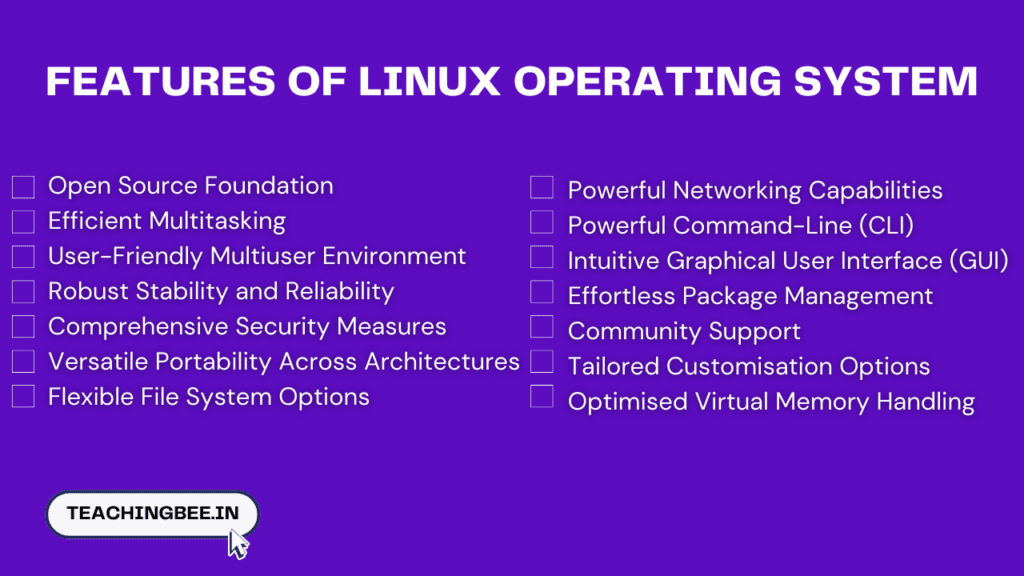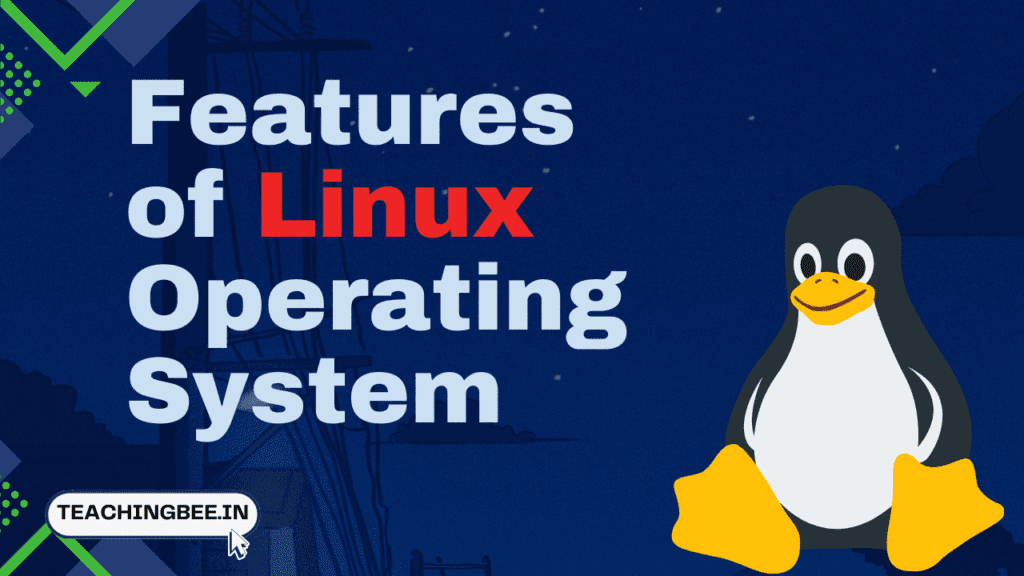Table of Contents
ToggleLinux and Windows are two of the most popular operating systems used on personal computers and servers today. In this article we will discuss main features of linux operating system, components of linux and also see feature-by-feature comparison between the two OS across parameters like cost, security, performance, ease of use etc.
What is Linux Operating System?
Linux is a robust, open-source Unix-like operating system that centers around the Linux kernel. Originally released in 1991 by Linus Torvalds, it has become a pivotal force in the world of computing. Operating systems such as Debian, Ubuntu, Red Hat Enterprise Linux (RHEL), and others are built upon the Linux kernel, forming diverse and feature-rich Linux distributions.
At its core, Linux is responsible for managing fundamental operating system functions such as process scheduling, memory management, and facilitating communication between hardware components and software applications.
Types of Linux Operating Systems
- Debian – Community developed distribution known for its stability and commitment to free software philosophies.
- Red Hat Enterprise Linux – Commercial distribution focused on security and reliability for enterprise use.
- Ubuntu – Debian-based popular desktop distribution emphasizing ease of use and regular updates.
- Fedora – Community distribution sponsored by Red Hat providing latest innovations on a regular release cycle.
- openSUSE – Community Linux built on SUSE Linux Enterprise codebase focusing on flexibility.
- CentOS – Free RHEL clone for those seeking binary compatible enterprise level stability.


What Are Main Features Of Linux Operating System?
Linux is a popular open-source operating system kernel that serves as the foundation for various Linux distributions (distros). Some of the main features of Linux operating system are:
- Open Source Foundation
- Efficient Multitasking
- User-Friendly Multiuser Environment
- Robust Stability and Reliability
- Comprehensive Security Measures
- Versatile Portability Across Architectures
- Flexible File System Options
- Powerful Networking Capabilities
- Powerful Command-Line (CLI)
- Intuitive Graphical User Interface (GUI)
- Effortless Package Management
- Community Support
- Tailored Customisation Options
- Optimised Virtual Memory Handling
Let’s look at these main features of Linux operating system in detail.
Open Source Foundation
The open-source nature of Linux fosters a collaborative development model. Users can access, modify, and distribute the source code, promoting transparency and community-driven innovation. This has led to a wide range of distributions catering to diverse user needs.
Efficient Multitasking
Linux implements a preemptive multitasking model, allowing the kernel to allocate CPU time to multiple tasks efficiently. Each process runs in its own memory space, preventing interference and ensuring the stability of the overall system.
User-Friendly Multiuser Environment
Linux’s multiuser support allows concurrent access by multiple users. Each user has a unique username and password, and user permissions ensure that individuals can only access their designated files and resources.
Robust Stability and Reliability
Linux is renowned for its stability in server environments. The modular design of the kernel, along with features like memory protection and process isolation, contributes to system reliability and prevents a failure in one part of the system from affecting others.
Comprehensive Security Measures
Linux employs a robust security model. File permissions, user authentication, and access control lists ensure that only authorised users can access specific resources. Regular security updates are released to address vulnerabilities promptly, and the open-source community actively reviews and improves the code for security.
Versatile Portability Across Architectures
The portability of Linux is facilitated by its source code and modular design. It has been adapted to run on a variety of architectures, including x86, ARM, PowerPC, and more. This adaptability makes Linux suitable for diverse hardware, from embedded devices to supercomputers.
Flexible File System Options
Linux supports a variety of file systems, each with its own strengths. The ext4 file system is commonly used for general-purpose computing, while Btrfs offers features like snapshots and checksums. The flexibility to choose file systems allows users to optimize for performance, reliability, or specific use cases.
Powerful Networking Capabilities
Linux excels in networking capabilities. It supports a wide range of protocols and services, making it a preferred choice for networking applications. Features like iptables and firewalld provide robust firewall capabilities, and tools like tcpdump aid in network troubleshooting.
Powerful Command-Line Interface (CLI) and Intuitive Graphical User Interface (GUI)
The command-line interface (CLI) in Linux is powerful and versatile, offering numerous commands and utilities. This allows experienced users to perform tasks efficiently. Additionally, Linux desktop environments provide user-friendly GUIs, making the system accessible to a broader audience.
Effortless Package Management
Package managers simplify software management. Tools like APT (Advanced Package Tool), YUM (Yellowdog Updater, Modified), and Pacman handle software installation, updates, and dependencies. This ensures a consistent and organized approach to software management, promoting system stability and ease of use.
Community Support
The Linux community is one of the most vibrant and supportive in the open-source world. Users can seek help on forums such as Stack Exchange and Reddit, access extensive documentation, and contribute to the development of the operating system. This collaborative environment fosters knowledge sharing and continuous improvement.
Tailored Customisation Options
Linux provides extensive customization options. Users can choose from various desktop environments (e.g., GNOME, KDE, Xfce), window managers, and themes to personalize the look and feel of their system. Additionally, the modular nature of Linux allows users to tailor the software installed on their system to meet specific requirements.
Optimised Virtual Memory Handling
Linux’s virtual memory management allows efficient use of physical RAM by swapping data between RAM and disk storage. This feature enables systems to run more processes than would be possible with physical memory alone, enhancing multitasking capabilities.
Components Of Linux Operating System
Several components of Linux operating system comprises that work together to provide a functional and versatile computing environment.
Key components of Linux operating system are:
- Kernel
- Shell
- System Libraries
- Init System
- Daemons
- Graphical Server
- Desktop Environment
- Utilities and Commands
- File System
- Bootloader
- Device Drivers
- Package Management System
- System Libraries
- X Window System
- GNU Tools
Kernel
The kernel, often referred to as the heart of the operating system, is responsible for managing hardware resources such as the CPU, memory, disk I/O, and peripheral devices. It facilitates communication between software and hardware components and oversees critical system services. The Linux kernel is modular, allowing users to load and unload kernel modules to extend functionality dynamically.
Shell
The shell provides a command-line interface where users interact with the operating system by entering commands. It interprets these commands and communicates with the kernel to execute them. Common Linux shells include Bash (Bourne Again SHell), Zsh (Z shell), and Fish.
System Libraries
System libraries are collections of pre-compiled code that provide essential functions and services to applications and the operating system. These libraries include the GNU C Library (glibc) and cover areas such as file operations, memory management, and network communication.
Init System
The init system is responsible for initializing the system during the boot process. It manages system processes, starts essential services, and ensures a smooth transition from the boot stage to the user environment. Modern Linux systems may use systemd, Upstart, or other init systems.
Daemons
Daemons are background processes that run independently of user interaction, providing various system services. Common examples include the Apache web server daemon (httpd) and the systemd daemon (systemd). Daemons typically start during system initialization and continue running in the background.
Graphical Server
The graphical server (commonly Xorg) is responsible for managing graphical displays. It provides the framework for graphical user interfaces, allowing applications to display graphics on the screen. Wayland is an alternative display server protocol gaining popularity.
Desktop Environment
A desktop environment provides a complete graphical user interface, including a desktop, icons, taskbars, and system tools. Popular desktop environments for Linux include GNOME, KDE Plasma, Xfce, and LXQt. Each offers a unique user experience and a set of applications.
Utilities and Commands
Linux offers a vast array of command-line utilities and commands for diverse tasks. These include core utilities like ls, cp, and grep, as well as more specialized tools for system administration, text processing, and network management.
File System
The file system organizes and manages data on storage devices. Common Linux file systems include ext4, Btrfs, and XFS. The file system provides a hierarchical structure, allowing users to organize and access their files and directories efficiently.
Bootloader
The bootloader, such as GRUB (Grand Unified Bootloader), loads the operating system into memory during the boot process. It also allows users to choose between multiple installed operating systems or boot into different modes, such as recovery.
Device Drivers
Device drivers facilitate communication between the operating system and hardware devices. They provide interfaces for peripherals like printers, graphics cards, network adapters, and storage devices. The Linux kernel includes a wide range of built-in device drivers.
Package Management System
Linux distributions use package management systems like APT (Advanced Package Tool), YUM (Yellowdog Updater, Modified), and Pacman to handle software installation, updates, and removal. These systems automatically manage dependencies and ensure a consistent software environment.
System Libraries
System libraries consist of pre-compiled code that delivers standard functions and services to applications. They promote code reuse, maintain consistency, and support developers in building robust and efficient software.
X Window System
The X Window System (X11 or Xorg) is crucial for running graphical applications in Linux. It manages displays, windows, and input devices, providing a foundation for the graphical user interfaces used in desktop environments.
GNU Tools
The GNU tools, including the GNU Compiler Collection (GCC), provide essential utilities and development tools. GCC allows developers to compile and build software on Linux, contributing to the open-source ecosystem’s growth and robustness.
Why use Linux Over Windows Operating System?
| Feature | Linux | Windows |
|---|---|---|
| Cost | Typically free and open-source. | Proprietary; requires purchasing licenses. |
| Source Code Availability | Open source, allowing customization. | Closed source; limited customization. |
| Security | Generally considered more secure. | Frequent target for malware; more susceptible to viruses. |
| User Interface | Diverse desktop environments available. | Unified interface with periodic updates. |
| Command-Line Interface (CLI) | Powerful CLI; scripting capabilities. | CLI available, but less integral to daily use. |
| Updates and Upgrades | Can be managed centrally; more control. | Automatic updates with scheduled restarts. |
| Performance | Efficient use of system resources. | Resource-intensive; may require more powerful hardware. |
| Customization | Highly customizable; open-source nature. | Limited customization options. |
| Software Availability | Extensive package managers; vast repository of open-source software. | Rich ecosystem with a focus on proprietary applications. |
| Multitasking | Strong support for multitasking. | Multitasking capability but may vary by version. |
| Community Support | Active and large community. | Large user base; official support channels. |
| System Administration | Robust command-line tools; powerful administration capabilities. | GUI-based administrative tools; PowerShell for advanced users. |
| File System Support | Supports various file systems. | Primarily NTFS; limited support for other file systems. |
| Compatibility | Excellent compatibility with open standards. | Broad application compatibility; legacy support. |
| Server Usage | Widely used for servers; robust server features. | Commonly used for servers; GUI-based server management. |
| Development Environment | Ideal for development; supports various programming languages. | Development tools available; focus on .NET languages. |
| Gaming Support | Limited native gaming support. | Extensive gaming support with DirectX; Steam compatibility. |
| Ease of Use for Beginners | Learning curve for beginners; depends on distribution. | Generally user-friendly; widely used in consumer environments. |
| Updates and Upgrades | Centralized update management. | Automatic updates with less granular control. |
| Resource Usage | Efficient use of system resources. | May require more powerful hardware for optimal performance. |
| Vendor Independence | Not tied to a single vendor. | Tied to Microsoft as the primary vendor. |
The choice between Linux and Windows often depends on specific use cases, preferences, and the technical requirements of the user or organisation. Each operating system has its strengths and weaknesses.
Key Takeaways
- Linux is open-source allowing customisation, while Windows is proprietary and closed source
- Linux offers centralised package management for streamlined updates compared to Windows automatic restarts.
- Linux provides very powerful command line usage scenarios not integral to Windows daily use
- Linux excels in multitasking capabilities as well as server environments vs Windows GUI-focused features
- Choice depends on specific use case – development, customisation require Linux while Windows suits consumer space
Checkout other design related posts here
I hope You liked the post 👍. For more such posts, 📫 subscribe to our newsletter. Try out our free resume checker service where our Industry Experts will help you by providing resume score based on the key criteria that recruiters and hiring managers are looking for.
FAQ
What is the Linux operating system, and how is it different from other operating systems?
Linux is an open-source Unix-like operating system kernel that serves as the foundation for various Linux distributions. Unlike proprietary operating systems such as Windows, Linux is freely available, customizable, and benefits from a large community of developers. It is known for its stability, security, and versatility across different hardware platforms.
How does package management work in Linux, and what are the advantages?
Package management in Linux involves the use of package managers (e.g., APT, YUM) to install, update, and remove software packages. These managers automatically handle dependencies, ensuring a consistent and organized software environment. The advantages include ease of software installation, efficient updates, and streamlined management of software dependencies, simplifying the overall system administration process.
Can Linux run on all types of devices, including desktops, servers, and embedded systems?
Yes, Linux is highly versatile and can run on a wide range of devices, from desktop computers and servers to embedded systems and IoT devices. Its adaptability is attributed to its modular design, support for various hardware architectures, and a diverse ecosystem of distributions tailored to specific use cases. Linux’s presence extends from personal computers to enterprise servers and even smartphones.
How does the Linux community contribute to the development and improvement of the operating system?
The Linux community is a vital force in the development and improvement of the operating system. It includes developers, enthusiasts, and users who actively contribute to the source code, report bugs, and provide support through forums and documentation. The collaborative nature of the community ensures rapid identification and resolution of issues, continual innovation, and the evolution of the Linux ecosystem.




